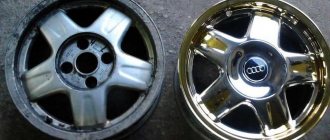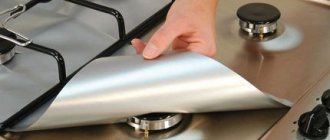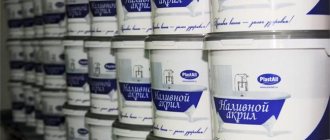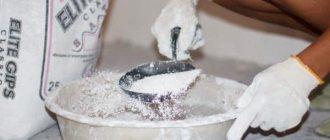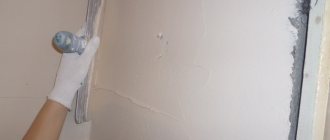Chrome plating of parts is one of the most attractive types of coatings used in car tuning. It gives the products a shiny silver look and also protects the metal from corrosion. Only neat and scrupulous people can perform high-quality chrome plating at home.
In this article you will find detailed instructions on how to chrome plating parts at home with your own hands.
At the end of the article, as usual, watch a video with the technology of the galvanic chrome plating process.
Before you begin preparatory work on chrome plating parts at home, you should compare the benefits of this undertaking:
- If there is a metalworking facility nearby, it likely has an electroplating area. You can place an order for little money, and finished products can be received in a couple of hours or days (depending on the load on the chrome plating line).
- If there is no such production in the vicinity, you will have to remember some sections of chemistry and physics, stock up on chemicals and special equipment, and chrome-plate the parts yourself.
Chrome plating of structures and parts in a home workshop
To protect parts of various mechanisms or parts of metal structures from corrosion, giving them additional wear resistance, hardness and improving the aesthetic appearance, chrome or nickel plating is used. These methods involve applying a chemically inert coating of chromium or nickel to the surface of structures, improving aesthetics. Applying such a film is an energy-intensive process. Technologically, it is complex, but it provides protection for many decades without any noticeable loss to appearance.
Often there is a need to cover with a decorative film those products that were not initially subjected to the chrome plating process. Thus, if desired, you can, for example, change the appearance of the sculpture and make the interior of any living space modern. You can decorate your car or motorcycle to your liking. It’s not at all difficult to do this even with your own hands, that is, without using complicated technologies. It is possible to apply a chrome film even on structures with complex relief, and not just convex, flat or concave ones.
Basic methods of chrome plating
- Chemical metallization process.
- Galvanization.
- Vacuum spraying.
- High temperature diffusion.
The last two methods are used only in industrial enterprises. These processes cannot be performed at home, since they require technically complex installations and increased energy costs. But chemical metallization and galvanization are exactly the same processes that can be carried out in a personal workshop. Let's take a closer look at how this is done.
Chemical metallization of surfaces and parts
In the process of this work, chemical reagents, a compressor and a spray gun are used. Almost the same operations are performed as when painting surfaces with acrylic varnish or enamel. When chrome plating in this way, not a protective polymer film is applied to parts and structures, but a mirror-like thin layer of metal. Its thickness is in the range of 0.075-0.25 millimeters. The chemical and physical characteristics of such a coating are comparable to those obtained by vacuum deposition.
How to perform chemical metallization
1st method. The surface is coated with special chemicals. As a result of the chemical reaction, a precipitate is formed, which is a durable metal layer. The coating can be made not only from chrome, but also from silver.
2nd method. During the process of a reducing chemical reaction, a layer of chromium is formed from the salts. Prepare a set of acetic acid, chromyl chloride, chromium chloride, chromium acetate, sodium hyposophite, sodium hydroxide, chromium phosphate. It must be remembered that these substances are very toxic and hazardous to health. And therefore, you should carefully study the chemistry textbook if you decide to carry out the chrome plating process using this method. But achieving high quality is very difficult, even with detailed instructions. Despite all the existing disadvantages, this method is most often used for chrome plating surfaces in home workshops.
It is very convenient to carry out the plating process using ready-made test kits of chemicals for chrome plating. They are offered by Fusion Technologies. The convenience of such kits is that the coating can be applied to any of the listed materials: metal, ceramics, wood, glass, plastic. Galvanic installations and special complex equipment are not required. All you need is a spacious room, distilled water, a compressor, a sprayer and a set of chemicals. In addition, you need to prepare a gas burner with a gas cylinder.
Safety regulations
- Ventilation device in the workshop. Opening doors and windows will not solve the problem. Install an ordinary kitchen fan into the window. This will be enough for amateur work. If you plan to work on a private enterprise scale, chrome plating a large number of spare parts for cars, decorative interior items, then you will need to install more efficient and powerful ventilation.
- Sewage equipment. The work will require large amounts of water to wash parts. Additional cleaning is not necessary, since it is chemically inert. But the drainage into the sewer canal must be equipped.
- In order not to expose the respiratory system and skin to dangerous effects of reagents, it is recommended to work with the use of protective equipment. Stock up on respirators, special safety glasses and a durable apron. You will also need several pairs of rubber gloves.
Read also: DIY sawdust press drawings
When performing chemical metallization in your personal workshop, do not forget about strict adherence to technology. Reagents should be applied to the surface in the specified order. This is followed by the application of a thin layer of silver. This metal is safe, unlike chromium and compounds. The finishing layer is in no way inferior to chrome in terms of characteristics.
A set of reagents for metallization consists of modifiers A and B, a reducing agent and an activator. At the very beginning of work, the reagents are diluted in the specified volume of distilled water. Proportions are strictly observed. Solutions should be stored in a cool place. You can buy the varnishes and pigments necessary for the work at the same store where you bought the reagents.
How to prepare for work
Chrome plating of plastic requires preparation. In order to do chrome plating, you will need to purchase special equipment, which is quite expensive. Therefore, if you are planning a one-time procedure, then it is better to turn to specialists, it will be much cheaper. If you plan to carry out chrome plating often, then you can take on this matter personally.
It should be kept in mind that chrome plating of plastic is carried out using caustic, volatile chemicals. Therefore, the room in which the work will be carried out must be well ventilated. A living space is absolutely not suitable for such a procedure; it is better to do chrome plating in a garage, basement or workshop. Volatile acidic substances evaporated during the procedure settle on interior items and can react with them and destroy them. You should also take care of personal hygiene products and stock up on the following items:
- respirator;
- rubber gloves;
- safety glasses;
- oilcloth apron.
During work, you need to protect your skin from contact with reagents, as chemicals will cause burns. There is also no need to inhale toxic acid fumes, this will negatively affect the condition of the body.
Galvanization
The galvanic method is the coating of cast iron, steel, brass or copper structures with a layer of chromium. But not only metal products can be chrome-plated by galvanization. This method can also be used for chrome plating of plastic and wooden products. But in these cases the process will be expensive and technologically complex. To firmly hold the chrome coating on the surface of parts, even metal products require another preliminary coating. For this purpose, nickel, brass or copper are used.
Galvanization requires the creation of a galvanizing plant. In addition, you need a DC source and a set of reagents. This set consists of chromium anhydride, sulfuric acid, soda ash and sodium hydroxide.
It should be noted that when working with this method, it is required that there are no changes in current strength. You also need to constantly monitor the level of salt concentration in the electrolyte and strictly observe the temperature regime for quite a long period (from 5 to 8 hours). Fulfilling all of the above conditions in home workshops is not an easy task. It is for this reason that we will not describe the galvanization process in detail in this review.
Chrome plating of parts is one of the most attractive types of coatings used in car tuning. It gives the products a shiny silver look and also protects the metal from corrosion. Only neat and scrupulous people can perform high-quality chrome plating at home.
In this article you will find detailed instructions on how to chrome plating parts at home with your own hands.
At the end of the article, as usual, watch a video with the technology of the galvanic chrome plating process.
Before you begin preparatory work on chrome plating parts at home, you should compare the benefits of this undertaking:
- If there is a metalworking facility nearby, it likely has an electroplating area. You can place an order for little money, and finished products can be received in a couple of hours or days (depending on the load on the chrome plating line).
- If there is no such production in the vicinity, you will have to remember some sections of chemistry and physics, stock up on chemicals and special equipment, and chrome-plate the parts yourself.
Preparation for the procedure
The painting process takes a lot of time and requires precision in all stages and preparation of equipment for chrome plating of parts. In addition, you will need special tools, but if you want to save money and do all the work yourself, then these “small” nuances will not hurt.
The first stage is the search for a suitable room in which the process of applying chrome to parts will take place. It must be selected carefully, taking into account all the necessary parameters. The room should be well lit, heated or have a constant room temperature. It is important to consider that there is ventilation and complete air isolation from the street. This is necessary in order to protect the parts from debris getting onto the painted surface.
The second stage of preparation for painting includes the preparation of personal protective equipment. You cannot use things or fabrics to protect your body. There must be such protection details as:
- respirator;
- protective glasses;
- gloves;
- apron.
The use of protective equipment will allow you to not break away from the work process for a long time and maintain your health.
The third stage requires provision in advance for the disposal of all waste that will be obtained in the technological process of painting automobile parts.
Preparing the installation for painting
Chrome plating of plastic at home involves the use of a special galvanic bath in which chemical and physical reactions take place. This device consists of several parts, so it will not be difficult to assemble it yourself.
The galvanic bath consists of the following elements:
- The container is selected taking into account the volume of the container for chrome plating.
- An ordinary three-liter glass jar is most often used as a container.
- For the electrolysis process to proceed efficiently, a wooden box with insulated walls is required. In fact, this part should resemble a thermos in its characteristics. You can create a wooden box that will retain heat if you use glass wool, mineral wool, fiberglass or sand as insulation.
- You will need to constantly measure the temperature, so it is best to have a contact thermometer and attach it to the installation, automating the technological process.
- The heating element is necessary for heating and maintaining a constant temperature. The power of the device is selected in accordance with the requirements and volumes of the bath.
- A sealed lid is made from a wooden board or plywood.
- During the chrome plating process, the product being processed is connected to a source of electric current at the negative contact, so wires are required. The anode is immersed in an electrolytic solution and connected to the positive contact. The wire that will be connected directly to the workpiece is best equipped with a crocodile clip for easy connection.
Additionally, you will need to think over a system similar to a conventional tap. Such a device is necessary to carefully and evenly lower the part into the galvanic bath. This is the only way to achieve an even layer of chrome without defects .
- What equipment is used for chrome plating and metallization?
Selecting a power source
Parts are coated with a layer of chrome when using direct current. In specialized services, special DC power supplies are installed for this purpose. A homemade assembly of a device for chrome plating must meet similar parameters. Basic requirements include:
- The power source used in the chrome plating process must be equipped with an output voltage regulation system. The simplest option for creating a regulator is to use a conventional rheostat.
- The wiring cross-section must have a maximum current carrying capacity. Even if the equipment is small, the wiring cross-section should be 6.25 mm.
- A DIY device must include a thermometer, but many people use a thermostat. This greatly simplifies the work, increasing the accuracy of temperature measurement, but such an element requires an appropriate electronic circuit.
Only through the correct selection of a power source will it be possible to carry out the electrolyte process and apply a layer of chromium to the product.
Rules for preparing electrolyte
If you have firm confidence and a desire to carry out the process of chemical chrome plating at home, and do not turn to specialists for help, then you will need to prepare, in addition to the galvanic bath, an electrolytic solution. To create this solution you will need to find the following components:
- sulfuric acid - 2.5 g/l;
- chromic anhydride - 250 g/l.
Both substances are quite dangerous, so all work is carried out in a special protective suit. The process of preparing an electrolytic solution is divided into several stages:
- First of all, the galvanic bath is filled halfway with water. It is recommended to use distilled water. If ordinary water is used, it is first brought to a boil and infused for 24 hours. Thus, all limescale and debris settle to the bottom of the container, and the water becomes suitable for preparing the solution.
- The water should be heated to 60 degrees Celsius. Only at this temperature is it possible to add chromic anhydride, stirring it constantly.
- In some cases, a chemical reaction leads to a decrease in water in the container, but it is allowed to add it to the required level.
- After thoroughly stirring the chromic anhydride, sulfuric acid is poured in.
- The finished solution must be subjected to “working”. This term is used by specialists to refer to the effect of current on a solution. Typically, electric current is passed through it for 3.5 hours. The current strength during “working” should be equal to 6.5 A per liter of chemical solution. Knowing the technical characteristics before starting the procedure will help you easily determine the volume of electrolyte.
- If all steps were performed correctly, the chemical solution will turn dark brown. After this procedure, it must be taken out for a day in a cool and dark place.
Equipment and materials for do-it-yourself chrome plating of parts
To apply a chrome layer to metal parts, you will need the following equipment:
- bathtub made of plastic or polypropylene;
- a rectifier capable of delivering voltage up to 12 volts and current up to 50 amperes;
- acid-resistant heater for heating the electrolyte;
- thermometer with a measurement limit of 0-100 degrees.
The parameters and dimensions of certain types of equipment used for chrome plating at home are determined by the size and number of products being processed.
In order to save money, you should select the minimum dimensions of the bath into which the parts will be immersed. The bath can be made from a plastic bucket or other rectangular container. To prevent the solution from evaporating during long-term storage, it is necessary to provide a sealed lid or container for draining.
A car battery charger can be used as a rectifier (it is suitable for chrome plating small parts).
Chromium plating of parts will occur in an electrolyte, which consists of:
- distilled water (atmospheric water or tap water with a low salt content is suitable);
- chromic anhydride (CrO3) with a concentration of 220-250 g/l;
- sulfuric acid (H2SO4) with a concentration of 2.2-2.5 g/l.
In addition to these components, you will also need materials such as: hydrochloric acid (HCl), acetone or solvent 646, and clean sheet lead.
What tools are needed?
Before you start chrome plating, you need to stock up on everything you need. Tools and materials should be at hand. To work you will need:
- glass or plastic containers for dielectric solution, the container must be resistant to acids;
- electrolyte solution;
- plastic bucket or basin;
- you will need to make a plywood box, trim it with fiberglass and insulate it with sand or mineral wool to achieve a thermal insulation effect;
- brush for applying the solution;
- heating element or other heating device;
- car battery or other electrical power source;
- a thermometer that allows you to measure the temperature of a liquid up to 100 degrees Celsius;
- an anode plate connected to an electrical source;
- bracket for hanging the elements being processed;
- a lid with which to cover the container, you can take a plywood sheet;
- clamp
The procedure for chrome plating parts with your own hands
Protective and decorative chrome coating can be applied directly only to metals such as copper, brass or nickel.
Read also: Airbrush technology on cars
To independently perform chrome plating on steel parts, a copper, brass or nickel underlayer is first applied to them. This requires an appropriate electrolyte and technology:
- Products to be chrome-plated are pre-polished and degreased with acetone.
- After drying, the surface is activated in a solution of hydrochloric acid (100 g/l). Treatment time depends on the condition of the surface (5-20 minutes).
- The parts are washed in clean water and immersed in a chrome plating bath. To do this, a pendant is made of copper wire or rod. The negative wire from the rectifier is supplied to the suspension with parts. Nearby, a lead anode is attached to a copper rod, to which the “plus” is supplied.
- After 20-40 minutes, the parts are removed from the bath and washed in clean water. After drying, the chrome layer can be polished to give the surface a mirror shine.
Preparing the electrolyte is not difficult: first, chromic anhydride is dissolved in water, and then sulfuric acid is added in a thin stream.
- Before loading the first batch of parts, it is necessary to hang any clean metal plate and work the electrolyte for 0.5-1 hour. When the color of the solution turns from bright red to burgundy, you can begin chrome plating the parts.
- The chrome plating solution should be heated to 45 degrees.
- The current strength is set depending on the surface area of the parts being coated. To process 1 sq. dm. current required is 15-25 amperes.
Main defects and removal of low-quality chrome plating
Receiving a defective coating should not frighten a novice electroplater. A poor-quality layer of chromium can be removed in a solution of hydrochloric acid (100-200 g/l). After this, the parts are washed in water, and the chrome plating process can be repeated.
Most often there are several main defects:
- Peeling of chrome film . The main reason is poor adhesion due to insufficient degreasing. After removing the coating, the surface is cleaned and reactivated again.
- Chromium growths (dendrites) on sharp edges and corners. This defect indicates a high current density on sharp edges. If possible, it is better to round the edges or install screens in problem areas.
- Matte finish . To achieve shine, it is necessary to increase the temperature of the solution, reduce the current, or add chromic anhydride.
Video: galvanic chrome plating technology
Do-it-yourself chrome plating at home is always useful not only for car enthusiasts, but also for those who want to get beautiful household items, cover vulnerable metal surfaces and give them an aesthetic appearance, and get parts that are visually similar to those made of chrome.
Chrome plating of parts at home is a relatively simple process and does not require expensive special equipment, and anyone who wants to and knows how to do it can do chrome plating with their own hands.
Chrome plating process
After the galvanic bath has been prepared, the chemical solution has settled, and the parts are already waiting in the wings, all that remains is to figure out how to chrome a part at home. The first step is to remove the chemical solution from a cool room and heat it to 53-55 degrees Celsius. This temperature must be maintained throughout the dyeing process. The anode is placed in the solution, and only after that the product is lowered on a bracket into the electrolyte. Next, you need to wait until the temperature of the part and the solution is the same, and apply electrical voltage to the anode.
After the chrome plating procedure, the product is removed from the solution and placed in a special oven for heat treatment for 2.5 hours. Basically, additional processing needs to be done to dry and set the chromium to the aluminum surface, although many argue that heat treatment significantly increases the hardness of the coating and makes it more durable.
Decorative chrome plating is a complex process that requires a thorough study of all theoretical material and watching a video tutorial on this topic. For the first time, it is best to carry out the work on a prototype in order to hone the entire process in practice, and only then proceed to painting the required parts.
A set of necessary tips and rules helps to avoid a lot of problems associated with defects in the application of the chrome layer. For example, if the shine of chromium is weak or absent, this indicates a small amount of chromic anhydride or sulfuric acid in the solution. Another common problem is the lame layer peeling off. This problem occurs when the voltage is unstable or the temperature drops during processing of the product.
Chrome plating is a beautiful way to transform your vehicle and make it truly unique and attractive on the road. There is nothing complicated in the process itself if you follow all the rules for preparing a chemical solution. The main thing is not to forget about safety precautions and the use of a protective suit.
Briefly about chrome plating
Decorative chrome plating is considered to be a business aimed at motorists who, by applying a chrome coating to the metal parts of a car or motorcycle, improve the appearance of their personal vehicles.
But chrome plating of car or motorcycle parts is not the only way to apply the process, and with the help of chrome plating at home, other parts are decorated and surfaces are refined.
Using DIY chemical metallization, people achieve visual effects in other aspects of everyday life:
- produce metal spraying on wooden parts of designer furniture;
- create metal-like designs for plastic parts;
- they make original souvenirs from ordinary objects using the chrome plating process;
- trim wheels and other metal parts of cars and motorcycles, creating a unique decorative set.
Improving the appearance and making it decorative is not the only goal of chemical metallization at home. With the help of chrome plating, the performance properties of finished surfaces are improved, their strength, wear resistance and hardness increase. Chrome parts last longer, and at the same time do not lose either their acquired shine or their guaranteed long-term properties in use.
Do-it-yourself chrome plating of parts, carried out in compliance with the necessary technologies, is also a way to avoid material costs that would be inevitable when contacting a workshop.
On video: chrome plating in real home conditions.
Chemical chrome plating
Chemical chrome plating is the step-by-step application of layers of chromium to a chrome-plated object, which is certainly made of metal. This is the optimal way to protect a part from atmospheric and electrochemical corrosion, while also solving the problem of improving the technical characteristics and appearance of the surface being coated.
Metallization at home can be carried out in several ways, but the most commonly used are:
- chemical;
- galvanic;
- spraying method.
Galvanic chrome plating at home is the most effective way to chrome any part.
Electroplating technology allows you to create products with reflective surfaces, apply a protective film, and not only add decorative properties, but also restore worn-out metal surfaces. To decide how to chrome plating and which method to choose, you need to decide on the available means and have at least a rough idea of each of these methods.
Read also: Doorbell evology instructions
Features of chrome plating
Although chrome plating can instantly change the appearance of a motorcycle or car, this procedure is quite complex and dangerous. This is due to the use of a special galvanic bath and serious reagents that can be harmful to health if the instructions are not followed. All chemical and physical transformations must occur under the strict supervision of a specialist, even if the procedure is carried out at home. Therefore, it is important to familiarize yourself with the entire theoretical basis before starting. Since chrome plating metal at home became a trend, a lot of different methods have appeared.
Chromium deposition is a physical and chemical process that occurs after the part is treated in a galvanic bath. A thin layer of metallic chrome is applied to the product, which hardens almost instantly. As a result, it is easy to obtain a body part with a shiny surface and resistance to external damage. Chrome plating significantly enhances the physical, chemical and decorative characteristics, so it is often used on the lower parts of the vehicle that are exposed to the external environment.
Technologies used
Equipment for chrome plating using the galvanic method requires the presence of a special container (bath) in which the process is carried out. Galvanic baths do not require compliance with certain parameters such as width or height; the main requirement that is placed on them is the ability to withstand the effects of acid.
The electrochemical method of chrome plating at home is based on the principle of electrolysis, known from school, in which current passes through a composition that includes acid, alkali and chromium salts. When a current passes, free chromium cations are formed, with the help of which it is possible to chrome the metal.
Important! The quality of the coating depends on how correctly the necessary components are selected and how scrupulously the technology is followed.
The main difference between chemical chromium plating and electrolytic chrome plating is that the reduction of chromium with salt solutions occurs with the participation of sodium hypophosphite, which is added to the solution, in contrast to the electrolyte used for the electrolytic method when processing metal surfaces coated with chromium.
Advice! The finished coating after a layer applied by chemical chrome plating is matte, and in order to give such a coating a characteristic chrome shine, the product must be polished .
However, the technology of finishing in chrome using a chemical method, in the absence of special decorativeness, compared to electrolytic coating, has higher reliability. Metal can withstand household loads better. The phosphorus contained in such a coating gives it hardness and strength, eliminating various problems.
Chrome plating of plastic: stages of work
At the first stage, the part is prepared. It is treated with a degreasing solution, which is prepared from the following components:
- soda ash;
- sodium hydroxide;
- silicate glue.
The ingredients are mixed in equal parts and diluted with water, then put on fire and brought to a boil. When the solution is ready, the part to be chromed is lowered into it.
After the part is degreased, proceed to the next stage - chrome plating. This can be done using a galvanic bath or a special brush. Everyone chooses the method that they consider most convenient.
Chrome plating with a brush
You can make a brush yourself. You will need a hollow tube made of plexiglass. A bristle is fixed to one end of it, which can be made from a bundle of bare copper wire. The brush is wrapped with a thin lead wire. The brush and the part are connected to the battery. A transformer can act as a power source, then the hand is connected to it with a diode, while the anode goes to the transformer winding, and the cathode is connected to the part. The diode is not useful for the battery.
Next, a reagent is applied to the part with a brush, which is poured into the glass handle of the brush before work. The procedure is carried out carefully, with smooth movements, you need to ensure that the solution spreads evenly. The solution is constantly added to the brush. The substance is applied in several layers. Each area is processed up to 35 times. As a result, the coating should be a thick, uniform layer.
Chrome plating using a galvanic bath
If chrome plating of plastic is carried out in a galvanic bath, the electrolyte is heated to 60 degrees and left for about three hours. The anode is lowered into the container, and the cathode is connected to the transformer. Then the part is lowered into the bathtub. It must be hung on a bracket so that the object in no case touches the walls of the bathtub, so as not to damage the uniformity of application of the substance.
The procedure is repeated several times until the chrome layer lies perfectly even. On average, the main process takes about half an hour.
The next step is to wash the part under the tap and boil it in three liters of water for half an hour. The treated element must be dried well for two hours. Do not touch the part until it is completely dry. To make the surface shine, it is polished with a soft cloth. At this point the work can be considered completed.
At the end of the work, care should be taken to dispose of the waste substance. Electrolyte should not be poured down the drain, much less splashed into the yard, since it contains harmful chemical compounds and acids.
Chrome plating of metal and plastic
Chrome plating of plastic at home is quite feasible if both the preparatory and main stages of the process are carried out properly. Chrome can be applied to plastic in a ventilated area, and definitely not in a residential area, because carrying out such processes in residential areas is prohibited by law. There is advice from competent people to do this in a garage or in a yard building.
Important! Do-it-yourself application of chromium must be carried out wearing protective clothing, a respirator, gloves and safety glasses.
The kit for applying chrome to plastic includes everything you need:
- container where chrome painting will be done;
- stand under the container to prevent splashing;
- a kind of heat-saving box, upholstered in fiberglass, with a hermetic lid;
- thermometer;
- heating device (you can use a very ordinary heating element);
- cathode and anode for chrome plating plastic;
- Brackets for hanging parts to ensure an even coat.
The chrome plating setup is extremely simple and is perfect for galvanizing or chrome plating plastic. Before making a chrome-plated part, you need to prepare the electrolyte:
1. The recipe for preparing the electrolyte is simple: chromic anhydride + sulfuric acid (H2So4). Chromic anhydride is poured into the heated distillate, stirred thoroughly, after which it is necessary to pour in the acid and stir thoroughly again. 2. The prepared composition is passed through a current until it becomes dark burgundy in color. 3. After this, the electrolyte settles for a day, and chrome painting can begin. The main rule: parts must be properly cleaned of grease, dirt, rust and scale.
When applying the composition, it is necessary to wear protective clothing and reheat the electrolyte, which must then sit again for at least 3 hours.
Then galvanization starts: parts are immersed in a solution at a temperature of about +50 and an electric current is started. Chromium plating of aluminum can be carried out using both galvanic and chemical methods, but chrome is applied to a preliminary copper-nickel sublayer, so it is difficult to do at home, but it is guaranteed to restore the damaged surface.
After soaking the chrome plating elements in the electrolyte, you need to wash them with water and dry them. If drying is carried out in a drying cabinet, the temperature should not exceed certain limits.
How the chrome plating process is carried out (2 videos)
Progress
First of all, you will need to make an electrolytic solution. It is prepared as follows:
- Distilled water is heated to 60 degrees Celsius. The volume of liquid depends on the size of the part.
- Chromic anhydrite is added to the heated liquid and stirred well. Anhydrite is taken in a ratio of 250 grams per liter of liquid.
- Then pour in sulfuric acid and stir again. Take 2.5 grams of acid per liter of water.
You need to run an electric current through the prepared solution; this will take about three hours. The substance should acquire a dark burgundy color.
The current strength is calculated taking into account that 6.5 A is required per liter of solution. The current strength should not be exceeded, this can lead to stains and uneven distribution of the mass. After this, the solution is left for a day. The prepared solution can be stored for several months, but only if the container with the liquid is tightly closed with a lid.
